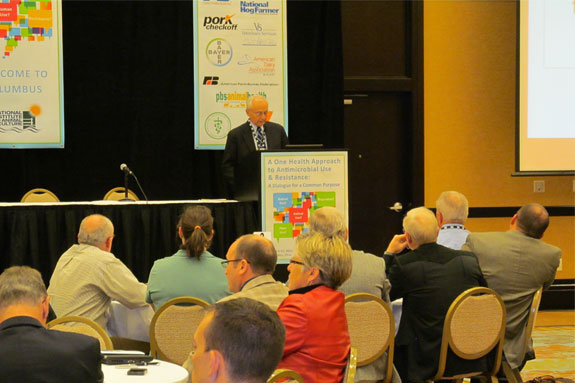A clear message emerged from the “A One Health Approach to Antimicrobial Use & Resistance: A Dialogue for a Common Purpose” symposium. The consensus was that antibiotic use and antimicrobial resistance is the responsibility of all communities – human health, animal health and environmental health – and solutions will require collaboration.
At the end of the symposium, which was held Nov. 13-15 in Columbus, Ohio, and coordinated by the National Institute for Animal Agriculture , presenters and participants agreed on numerous points:
- Antibiotics dramatically improve human, animal and plant health, and increase life expectancy.
- Antimicrobial resistance is not going away. A historical look at antimicrobial resistance shows that it is not a new phenomenon but existed before mankind.
- The topic of antimicrobial resistance can be subtle, complex, difficult and polarizing. It is more than science and evidence – it’s about politics, behavior, economics and conflicting opinions.
- Antimicrobial resistance is not merely a consequence of use; it’s a consequence of use and misuse.
- The finger-pointing for antimicrobial resistance needs to end. The time has come to work together.
 “Finding a solution is not about compromise; it’s about reaching agreement,” stated Lonnie King, dean of The Ohio State University College of Veterinary Medicine, who opened the symposium.
“Finding a solution is not about compromise; it’s about reaching agreement,” stated Lonnie King, dean of The Ohio State University College of Veterinary Medicine, who opened the symposium.
“We (animal health, human health and environmental health communities) need to find common ground – something we all can agree to when we disagree on other issues.”
The November event built upon information and consensus from a previous symposium held in October 2011, which resulted in a popular white paper detailing various aspects of antibiotic resistance.
Topics addressed this year by the 13 experts from the various health communities included:
- Overview of antibiotic use
- History of antimicrobial resistance
- Antimicrobial resistance surveillance
- Environmental contamination with antimicrobial residues
- Interplay of animal and human antimicrobial-resistant populations
- Nationally funded antimicrobial resistance research projects
- Alternatives to antibiotics in agriculture
The symposium included interactive sessions during which attendees addressed questions and provided input. Answers were synthesized so group consensus could be reached. Each table brought together people from different disciplines.
 “The symposium’s four interactive sessions allowed presenters and attendees to provide input to questions that moved the group to consensus,” stated Leah Dorman, co-chair of the symposium and director of food programs at the Ohio Farm Bureau.
“The symposium’s four interactive sessions allowed presenters and attendees to provide input to questions that moved the group to consensus,” stated Leah Dorman, co-chair of the symposium and director of food programs at the Ohio Farm Bureau.
“In the end, it was extremely evident that the dialogue among the animal health, human health and environmental health communities is critical to a solution.”
Presentations by symposium speakers will be available at www.animalagriculture.org . A white paper is being developed and will be available on NIAA’s website as well. PD
—From National Institute for Animal Agriculture news release
PHOTOS
TOP RIGHT: Dr. Kurt Stevenson provided information about human health, including the fact that 200 million to 300 million antibiotics are prescribed annually. A new focus among physicians is antibiotic stewardship.
MIDDLE RIGHT: Dr. Lonnie King opened the symposium and urged collaboration among human health, animal health and environmental health leaders to address antimicrobial resistance.
BOTTOM RIGHT: The group photos were taken during the interactive sessions where attendees addressed questions and provided input. Photos courtesy of The National Institute for Animal Agriculture.





